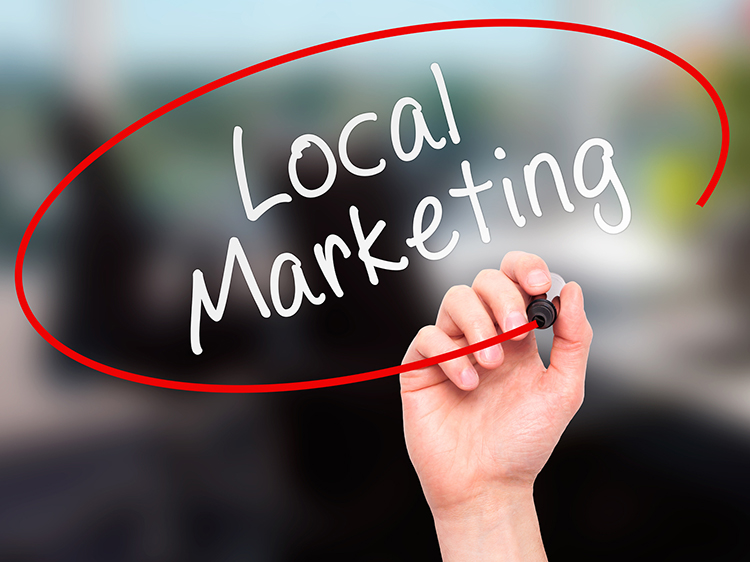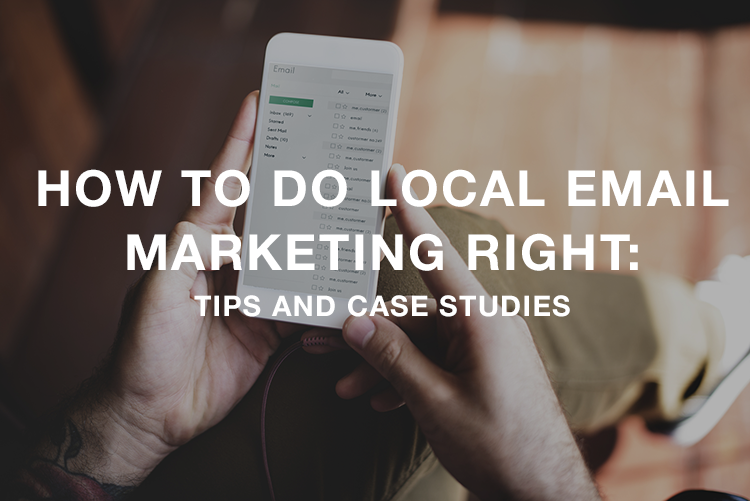Email Marketing
Email marketing is not dead. The stats are clear:
- 72% of American adults send or receive emails via their smartphones at least weekly.
- 81% of online shoppers in the US are likely to buy more as a result of targeted emails reflecting their buying habits.
- email is the most effective way to get and retain customers’ attention.
Far from being dead, email marketing is alive and well. Speaking at the Minnesota Blogger Conference on trends affecting bloggers, award-winning marketer Arik C. Hanson said that while RSS (the technology that makes it easy to subscribe to blogs) is on its way out, email newsletters are on the rise. That’s because email newsletters make it easy to start and nurture customer relationships and to engage in one-to-one communication.
Using Email for Local Marketing

Man Hand writing Local Marketing with marker on transparent wipe board. Business, internet, technology concept.
And those same features make email a great tool for local marketing. You hear a lot of talk these days about localization – creating an experience that is tailored to their location and interests. As Don DePalma, Chief Strategy Officer and founder of Common Sense Advisory, says:
“Localization improves customer experience and increases engagement in the brand dialogue.”
Done right, localization goes beyond customization and personalization, as Balihoo’s Amanda Cash-Crowley points out: “Localization means right message, right consumer, right time, right place.” That’s what businesses need to truly connect with their ideal customers.
5 Local Email Marketing Case Studies
Here are some examples of companies that use local email marketing successfully.
1. Sony Achieves 580x ROI
Sony Playstation wanted to sell a new game console model to both existing users and new subscribers. For the email marketing campaign, the company used segmentation to target customers with different needs and localization to present offers they could redeem in the most appropriate way, either via in-store coupons or Amazon vouchers. For each euro spent on the campaign, Sony earned 580 euros, and more than 9,000 people purchased the new console.
The lesson: Go the extra mile to ensure that customers can actually use local offers.
2. Vault Brewing Gets Personal
Vault Brewing wants to create a personal connection with each customer and uses local email marketing to reinforce that. The company increased take-up by sharing its newsletters on Facebook, resulting in greater reach. One unusual feature is that all emails are signed by the company founder. Vault also goes ultra-local by collecting new email subscribers in person, via an end-of-meal survey or an iPad subscriber app which they take to live events.
The lesson: combine email marketing with in-person marketing for greater reach and effectiveness.
3. Crocs Increases Engagement with Glocal Approach
Crocs sells its footwear in 90 countries with different approaches to email and different technology. To ensure a consistent brand experience wherever customers interacted with the company, Crocs created email playbooks based on successful US campaigns but customized for the different regions. This glocal approach led to the launch of 109 different emails and an increase in engagement and click through rates compared to emails sent without the playbook.
The lesson: Combine known best practices with local preferences to market effectively worldwide.
4. Oak Furniture Land Boosts Email Revenue by 40%
Oak Furniture Land used email marketing to make a connection between its 62 physical stores and its online presence. To do this, it collected postcode information from customers who signed up for emails and used this to geo-target a pre-Christmas email marketing campaign. This involved creating messages which related to customers’ local stores. The result was a 40% increase in revenue generated by emails for the period.
The lesson: The more relevant your offer is, the more likely it is that customers will take it up.
5. Logan Squarist Hyperlocal Emails Drive 9% of Web Traffic
A community organization looking to promote the regenerated Logan Square area and shift coverage away from crime to more positive news set up multiple hyperlocal email campaigns covering daily and weekly news roundups, events and a daily to-do list. The Logan Squarist emails had a 31% open rate and a 10% click through rate, driving 9% of website traffic. In addition the organization shared content on social media and organized local meetups. The organization has continued to grow and the site now has more than 12,000 visitors per month.
The lesson: Social media integration can make hyperlocal email marketing even more successful.
7 Tips on Successful Local Email Marketing
So, how do you achieve similar success with local email marketing for your business? Here are some tips.
- Go mobile. Your customers are reading email on their smartphones and they will act more quickly on what they read than those reading on the desktop.
- Use local subject lines. Using a subject line that relates to the local area can significantly increase open rates. In this case, Imagination used this technique to increase open rates by 7 percentage points.
- Automate where needed. Using automation to send customers reminders can raise awareness of your offers and boost opt-in rates.
- Segment your list by language and region so you can hyper-target email marketing. It’s also wise to be aware of specific laws governing email marketing in particular regions.
- Keep forms short and simple and encourage signups in-store. Use a tablet so you don’t end up with illegible information.
- Test your campaigns. Vary subject lines, images and content to see refine works best for customers in different regions. In the long term, that will make your local email marketing campaigns even more successful.
- Go hyperlocal. It’s worth repeating that this is the new trend in email marketing. The idea is to market relevant content to the audiences that need it now. What they need will change depending on where they are – and the mobile revolution puts this information at your fingertips.
Over to you. What are your favorite local email marketing campaigns?
Sharon Hurley Hall is a professional freelance writer and blogger. Her career has spanned more than 20 years, including stints as a journalist, academic writer, university lecturer and ghost writer. Hire Sharon to write posts like this, and connect with her on Twitter @SHurleyHall.

